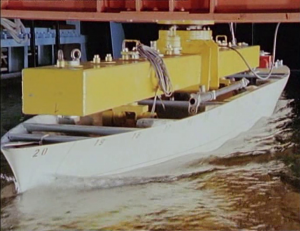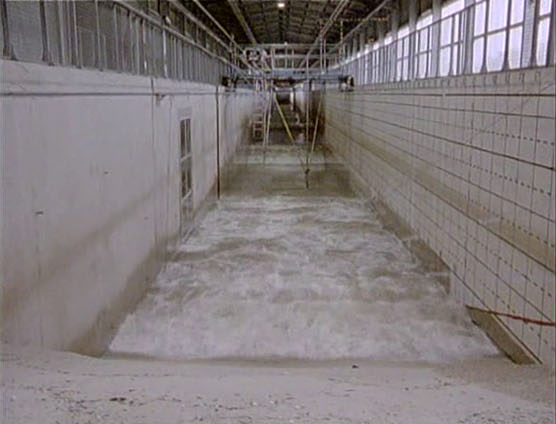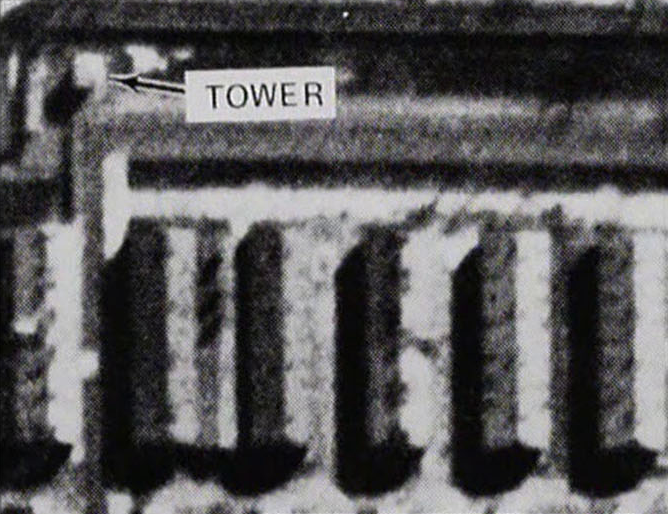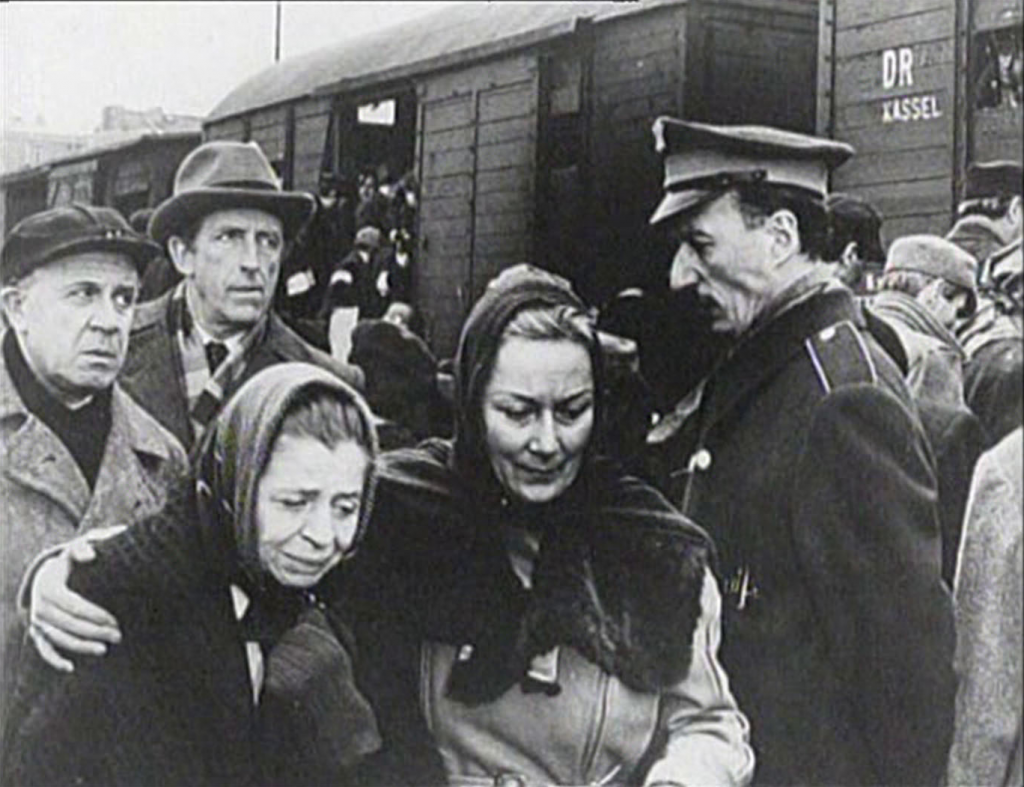The Uncertainties of Dialectics
18 Aug, 22
click here for original pdf
Images of the World and the Inscription of War: this film, more than any other, produces the kind of vertigo peculiar to Farocki’s films. The principle underlying this vertigo is easy to define. From the first image, the viewer feels that he is led securely by the hand, firmly guided through a demonstration. However, as the film moves forward, he is less and less sure of what the filmmaker wants to demonstrate to him, less and less sure that the pedagogue himself knows where he is taking him. Yet everything seems to proceed according to the principles of the most rigorous dialectics. Unlike ordinary pedagogues, the guide is not content to dissuade the student from believing what he sees and incite him to see what he does not see. He keeps on shaking his head through this double operation that dialecticians master so well: to compare and oppose; to compare things that have nothing in common apparently in order to show that they belong to the same overarching logic; to show that activities falling under the same principle produce opposite effects, because contradiction is the law of history. One could say that the film comes down to illustrating the relation between two simple Heraclitean propositions: that which shows hides; that which produces destroys. At this point, however, arises a twofold question: what operations should be undertaken to show the relation between the four terms? What effects do they produce in return on this relation? What form of visibility is involved in revealing what was hidden? What is produced in showing the link between producing and destroying? In brief, the simple dialectics borrowed from Marx and Brecht, which consists in revealing behind the visible appearance the power of the totality made of contradictions, meets its underside, as formulated by Adorno and Horkheimer: the light shed in this way on the connection of phenomena is itself part of the destructive operation that knows things only to better subject them to an operation of absolute control. Hence the need for dialectics to endlessly redouble itself, uncertain as to how it should show and to what the demonstration should lead, in order to avoid the risk of contributing to what it is denouncing.


Images of the World and the Inscription of War takes this contradictory relationship between dialectical rigor and dialectical irresolution to the extreme. The first image, which shows swirls of water in an experimental canal with no visible connection to any inscription of the war, announces the structure of the film, itself made of the comings and goings of dialectics: blocks of images, like musical themes, appear and disappear in order to reappear again, the overall meaning having to be established from the apparent lack of connection between them: the history of the invention of “photogrammetry”, a posing session in a painting academy, colored virtual images, grey archive images, make-up sessions, operations of simulation, digitization, interpretation of digitized images, which take us on a journey between the photography of the 19th century and the computer programs of the end of the 20th century, between the hushed universe of architecture offices and the images of the arrival of trains and the selection process on the Birkenau ramp. From a distance, the overall meaning of the demonstration is clear: to produce images is to ensure control over the things thus recorded; to ensure control over things is to acquire the means to destroy them. Destruction itself is an instance of productive industry. Seeing machines, producing machines, and war machines of destruction belong to the same global scheme. An exemplary case of knowledge/power: Foucault, in short, brings Marx and Adorno into agreement, even if he integrates their arguments into sequences of a different tonality. Yet this dialectics falters at what should have been the point of absolute coincidence: the coincidence between production of images and destruction, in the specific case of absolute destruction. Two images come to confuse the demonstration: two images from Auschwitz, one that is faulty, the other excessive.
The first image is, of course, the photograph taken on April 4, 1944, by an American airplane: a photograph showing without seeing the installations of the Birkenau camp – without seeing them because the pilots were not in charge of that but of dropping their bombs on the nearby installations of the Buna factories, and because the cameras were embarked on the fighter planes in the first place in order to monitor the performance of the pilots. Neither did those who were entrusted at the time with the task of analyzing the image see therein the operation of destruction of a people carried out nearby, because they were interested in another destruction, that of a factory producing war material useful to the enemies. The situation is therefore clear: if no one saw what was in the image, it is because one destruction was hiding another; because seeing was entirely determined by its submission to the logic of industrial and military warfare. This explanation does not raise any problem. The problem is to know what to do in 1987 with this image that shows something that had not been seen in 1944, what can be revealed and produced with it. For it is not because this image was not seen in 1944 that the question arises about it, but because it was seen anew thirty years later: because, in 1977, the interest aroused by the series Holocaust led two CIA agents to examine what was seen on these archive photos and to recognize in the apparently abstract grid of uniform rectangles the buildings of the inmates, the administration offices, the gas chamber, and perhaps even the vehicles transporting Zyklon B. But what did they exactly do thereby, asks the dialectician commentator? They identified on the photograph the knowledge acquired in the meantime by the sketches of Alfred Kantor and the account of Rudolf Vrba and Alfred Wetzler. Revealing nothing that was not already known, doesn’t this gesture of monstration participate itself in the logic of mastery that commands the will to visibility without rest? “There must be pictures of everything […]. The evaluators ‘verify’ – that means, they establish the verity of the existence of the camp down to the last detail, and they do this with relish for their role as specialists.”[1] This is what the commentator tells us, while “looking” at the two agents at work. But what is the filmmaker himself doing? He also examines the photos, enlarges them, helps us see on the blackened and white spots what the American pilots and the British intelligence officers could have seen: the crematorium, a flowerbed next to it, the room for undressing, the gas chamber, the four openings through which the Zyklon B was poured, and not far off, those who were not directly sent to death and lined up to be registered. “Here in August 1944 we see them waiting to be tattooed, to have their hair shorn and to be allocated work.”[2] Yet we don’t see any of that: at most we perceive, thanks to the big enlargement, a small serpentine black line that we could, because we know it, identify as a queue, the commentator having to tell us, moreover, who the people composing it were and what lay in store for them.
[1] Harun Farocki, “Commentary from ‘Bilder der Welt und Inschrift des Krieges’”, Karen Margolis & Bert Papenfuß-Gorek (trans.), in: Discourse, 1993, 15(3), pp. 78-92, pp. 81-82.
[2] Ibid., p. 91.
The demonstration of what there was to be seen, which the allies in 1944 did not see, is in a way superfluous: the first time we “see” the image taken by the American pilots on the screen, we see it in the form of an enlarged detail on which the camp buildings already bore the names inscribed in 1977. Like the CIA employees and the filmmaker, we are pleased to see an image illustrating what we know. The Allied analysts of 1944 had obviously no reason to share this pleasure, nor the possibility to do so.

The virtues of reading images are therefore quite minimal in this logic. In order to reinforce the demonstration one more step is needed: not only the photographs of Auschwitz but also the way to look at them needs to be included in a dialectical series, which questions not simply the defect of the image but also the reason for that defect, the way in which the image was produced, and the way it was looked at: not only a desire for mastery but the quest for a certain mode of mastery that produces a certain worldview: visibility from a distance, from above, the kind that avoids the risks involved in being too close to one’s target, where vision is blurred and the body is also in danger. This worldview can be summed up in one word, one that explains how the desire to know and the desires for power can coincide and how the clarity of the image can serve the goals of destruction: Aufklärung – the Enlightenment of Reason inventing new means of seeing and knowing, but also military reconnaissance and police identification. It is this dialectics of reason that is developed with the introduction of the block of images on the history of the invention of photogrammetry: the indirect technique of measuring buildings that we owe to the ingenuity of another civil servant, the architect Meydenbauer, who was commissioned to draw the plans of the façade of Wetzlar Cathedral. Having almost fallen from the basket he was using for this purpose, Meydenbauer realized that there was a less perilous way of taking these measurements by applying to the automatic recordings provided by the new technique of photography the old formulas of the theory of perspective taught by the masters of the Renaissance. In this way, it was possible to combine two seemingly contradictory advantages: seeing from above and seeing without risk – seeing better what one wishes to see, at the price of not seeing everything. It is this double advantage – and this “marginal” risk – that aerial photography offers and that is illustrated by the photographs of April 1944. However, the straight line going from Meydenbauer’s basket to the aerial photographs of Auschwitz is itself deviated by another two apparently contradictory series: first, the catalog of photographs of Algerian women taken by a French soldier during the Algerian war to make their identity cards: photos of women as if assaulted by the obligation of showing their faces unveiled in front of a stranger. These images would easily fit into the dialectics of the gaze that captures in order to dominate and hurts while capturing. Yet this is not the aspect emphasized in the commentary. Indeed, the question that is raised is apparently unconnected with the demonstration of the effects of geometry: how to face a camera?
However, this question raised by the faces taken in close-up seems in turn to be suspended by the play of another series of images that exclude any face to face with a photographer or a viewer: digitally produced images, whose context is sometimes explained to us – an analysis program that is capable of recognizing moving objects and identifying people and vehicles in aerial photographs –, and sometimes not – flight and landing simulations whose function remains obscure. The meaning of their insertion is less to be sought in the night of domination where all cows are gray than in a specific property they have: they are also images from a distance, images “from above”. And images “from above” have specific properties: they present the world “like a carpet”; a set of abstract patterns, a grid that reflects a calculation. To put it in a nutshell: every image “from above”, every image taken from a distance, without risk for the bodies taking it, is already a “digital” image: an inhuman image that is only the result of a calculation and that lends itself thereby to every kind of inhumanity. Here, Meydenbauer’s story takes on its full meaning and perhaps Adorno – not to say Heidegger – indisputably takes precedence over Marx; the evil in images is what subordinates them to the operation of mastery par excellence: the operation of measurement. Meydenbauer does not see: he measures. And thus, his inventions foreshadow a future where the images of the world will in fact become numbers. The link between photography, war, and destruction should be understood within this logic. The successful/failed photograph of Auschwitz, with its abstract grid, is already a digital photograph. But photography carries within itself, since it was subjected to the task of measuring, a death of the image that belongs to a broader enterprise of production/destruction. Though not stated, this is what is shown in these undercommented surveillance or digital simulation images that look like children’s games in a virtual universe. If the voiceover that accompanies them is inconspicuous, the filmmaker is not afraid, when questioned, to dot the i’s and cross the t’s – at the risk of surprising his interpreter: is this really how one should understand you, asks Thomas Elsaesser; is it indeed the disappearance of images that makes the link between fascism and virtual reality? Yes, replies Farocki, “a process of human self-abolition is underway.” The film inserts the history of Auschwitz and its images in a broader process whose current manifestation is the nuclear threat, even though this prophetic aspect of the film “has largely passed unnoticed.”[1]
[1] Harun Farocki, “Making the World Superfluous: An Interview with Harun Farocki”, in Harun Farocki. Working on the Sight Lines, Thomas Elsaesser (ed.), Amsterdam, Amsterdam University Press, 2004, p. 185.

Nonetheless, it is perhaps possible to break this circle: the gesture of the fingers can itself be inserted in another series: the one that links the precision of manual actions to the courage of action, opposing a human logic in act both to the inhumanity of technique and to the ambiguous humanity of the gaze on the unknown woman of Auschwitz. The pure pleasure of identification of the CIA agents is at odds with the actions that led to their knowledge: the drawings of Alfred Kantor who had carefully engraved in his mind the configuration of the site so as to provide an exact drawing of it after his liberation; the actions of two prisoners from the Kanada section, Rudolf Vrba and Alfred Wetzler, who transformed their task of selection into an archival work of memory in order to organize meticulously their escape thereafter and write the report that was to reveal the functioning of the death machine. The bombs of the American pilots, their photographs from seven thousand meters which transform the images of destruction into a digital carpet, or the algorithms producing virtual images, all contrast with the action of the inmates of Auschwitz who used the numbers of a coded language in order to prepare their rebellion, whose result can be seen in one corner of an aerial photograph: the partial destruction of crematorium IV by members of the Sonderkommandos, using powder stolen by young women working in the munition factories. This is how the dialectical path of the film ends: by the mention of the heroic action of these inmates who managed to do what the gigantic war machine of the Allies was unable to do: to make a death facility unusable. This opposition can certainly be formulated as a strict dialectical reversal: a movement going from numbers to the image against one that transforms images into numbers. But it is also the point where the result of the dialectical demonstration comes to disrupt its all too perfect machinery. One can indefinitely follow in the footsteps of the enemy and use the images of the great machine in order to make people see what it shows without saying it and explain the logic of power that is at work in showing without showing. But at some point, it becomes clear that this critical operation is completely futile and that the only thing that counts is the action that simultaneously interrupts the functioning of both the machine of power and the machine of interpretation that unveils it. It is no longer Roland Barthes that comes to mind here but Guy Debord. Debord knew that the unveiling of the machine of the spectacle is bound to last as long as the machine itself for a reason that he summed up in a short sentence: “In a world that is really turned upside down, the true is a moment of the false”[1]. Hence, there is no need to reveal the truth of what the riders filling the screens in westerns do. What is needed is to do in the real what they do in the image: charge at the enemy. In The Society of the Spectacle, this was not without a paradox: the image of the struggle against imperialism, which was to be carried out hic et nunc, was to be taken from Errol Flynn/Custer charging, sword in hand, at the head of the 7th Cavalry Regiment. To turn his film into an action against the death machines of 1987, and no longer a useless demonstration of how yesterday’s death machines worked, Harun Farocki undoubtedly has a less ambiguous example than the fictional stampedes of Errol Flynn or John Wayne: the action of the five young women of Auschwitz who stole the gunpowder and of the members of the Sonderkommandos who, on October 7, 1944, attacked the executors of the industrial death machine with hammers, axes, and stones. But the eyes of the viewer, when called upon to see in the image the effect of the numbers used by the insurgents, have great difficulty discerning it: no matter how enlarged the image is, it only shows the destruction of crematorium IV to those who already know that it took place. All that is left of this heroic action are words: these, we know it since Burke, have to take the place of images when it comes to expressing or producing an exceptional affect. But yet, there are words and words, and there is always a moment when the words of criticism must give way to words of indignation and admiration. It is also the moment when dialectics, in order to reach a conclusion, must call for pure action that interrupts all dialectics. “Reality has to begin”, Farocki tells us, echoing the words of Günther Anders.[2] Originally, the film had effectively an objective: to call on the Germans of 1987 to do, by preventing nuclear installations on German soil, what the Allies had not done in 1944 on Silesian soil: to sever the channels of the work of death. Twenty-seven years later, it became a classic in the well-established genre of image criticism. To be sure, it is difficult to measure as much the effect of images as the effects of their criticism. Reality is slow to begin.
[1] Guy Debord, The Society of the Spectacle, Ken Knabb (trans.), Canberra, Hogoblin Press, 2002, p. 8.
[2] Harun Farocki, “Reality would have to begin”, Marek Wieczorek, Tom Keenan & Thomas Y. Levin (trans.), in: Harun Farocki. Working on the Sight Lines, op. cit., pp. 193-202, p. 193.
translated by Philippe Farah
English translation first published in
Cinema-Journal of Philosophy and the Moving Image 12, “Images of the Real”
Originally published in French as “Les incertitudes de la dialectique”, in Traffic n.93, Spring 2015, pp. 96-103.